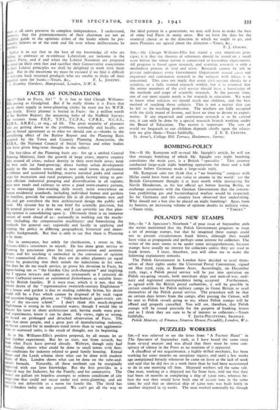FACTS AS FOUNDATIONS sot,—" Stick to Facts, Sir! " It
is fun to find Clough Williams- Ellis posing as Gradgrind. But if he really thinks it is Facts that are in short supply in town-planning circles he must use his W.P.B. eery freely. Every planner is buried in Facts : the 2 million words of the Barlow Report; the mounting bales of the Nuffield Survey; the torrents from P.E.P., T.P.I., T.C.P.A., C.P.R.E., N.C.S.S., A.R.R.C., et seq., ad lib. The great majority of planners who are getting down to the problems, nationally and locally, are now in broad agreement as to what we should aim at—thanks to the crystallising effect of the Barlow Report and the Planning Basis accepted by the Town and Country Planning Association, the R.I.B.A., the National Council of Social Service and other bodies who have given long-term thought to the subject.
The key-ideas of the Planning basis are : Set up a unified Central Planning Ministry; limit the growth of large cities; reserve country belts around all cities; reduce density in their over-built areas; keep the best soils for food-growing; direct further urban development mainly to the smaller towns and to new small towns in preference o ribbons and scattered building; reserve national parks and coastal trips for recreation and rural purposes; guide factory siting to pro- mote efficient industrial grouping and diversification in all regions; place new roads and railways to serve a good town-country pattern, not to encourage time-wasting daily travel; insist everywhere on uman residential standards, including individual homes and gardens or families; provide for community life in all development new and old; and get everyhere the best architectural design the public will stand. My résumé has to be too brief for scientific precision, but the general picture is a clear one, and I can certainly say that plan- ning opinion is consolidating upon it. Obviously there is an immense amount of work ahead of us: nationally in working out the machi- nery (including the compensation machinery) and formulating the standards for general use; regionally and locally in applying and adapting the policy to differing geographical, historical and demo- graphic backgrounds. But that is only to say that there is Planning to be done.
Not in annoyance, but solely for clarification, f retort to Mr. Williams-Ellis's references to myself. He has done great service to Planning by passionate pleas for rural preservation and aesthetic design; and his teaching is embodied in the consensus of opinion I have. summarised above. He does not do other planners an equal service by projecting into their minds the indecisions in his own. Nor does he do me much service, or prove his devotion to Facts, by pigeon-holing me as " the Garden City arch-champion " and implying that I oppose terraces and squares as strenuously as I certainly do oppose Corbusier-towers or continental Zeilenbauen as suitable hous- mg for British families. If it were true, which it is not, that the proved desire of the " representative twentieth-century Englishman " for a house and garden is due to reading rubbishy fiction, his desire would still be a Fact which cannot be disposed of by such vague and question-begging phrases as " fully-mechanical quasi-rustic cot- tage of the tea-cosy school." I don't think this much-despised Englishman is wrong in his essential wants; though I would like. to educate his taste in sheer architecture and, having made some prac- tical experiments, know it can be done. My views, right or wrong, are based on prolonged and detached observation of Facts. The view that most people, and a great part of manufacturing industry, are better catered for in moderate-sized towns than in vast agglomera- tions or scattered units, is the result of thought, not its beginning.
As to Mr. Williams-Ellis's positive proposal, by all means let us have further experiment. But let us start, not from scratch, but from what Facts have proved already. Welwyn, though only hid built, already shows what could be done in small towns with first- class conditions for industry related to good family housing. Kensal House and the Leeds scheme show what can be done with modern blocks of flats. London shows what can be done on the tube-and- suburb formula. Naturally, all these methods can be marginally improved .with our later knowledge. - But the first provides in a balanced way for Industry, for the Family, and for community. The second are gallant yet hopeless attempts to redeem conditions of city congestion that could not occur under real town-planning, and are certainly not defensible as a norm for family life. The third has few defenders today on any ground. We can't get all the way to the ideal pattern in a generation; we may still have to make the best of some bad Facts in many areas. But we have the data for the essential choice as to the direction in which we ought to go; and most Planners are agreed about the direction.—Yours, &c.,
F. J. OSBORN.


























 Previous page
Previous page